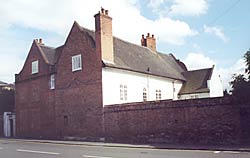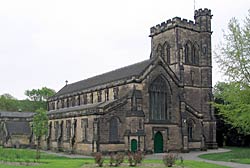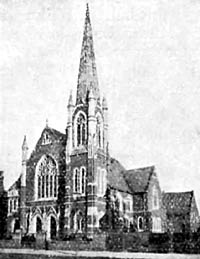
The Manor House, Beeston, was built in the late 17th/early 18th century (photo: A Nicholson, 2003).
Old Houses. The houses in Saxon times would cluster about the church, and some would stand in a line parallel with the Pasture dyke, extending from the West-end, by the Cross, to the "City." The "City" in the early part of the last century had some small low cottages built of stud and mud, and covered with thatch. Ceilings were in the olden time low, the windows small, the ventilation bad, especially in the bedrooms, which were principally in the roof, the windows being near to the chamber floor, and the provision as to pantry, sink, drains, pavement and sanitary conveniences very defective. The water in the wells became polluted, and so diseases were frequent. Consumption and small pox claimed their heavy toll, and the more so before vaccination was adopted. There were on the eastern side of the church yard some alms-houses, called the Poor Row, because the approved tenants lived rent free, but the dwellings became very dilapidated, and when the church was rebuilt they were taken down, and yew trees were planted in their place. Old people tell of two alms-houses formerly standing in Brown Lane. The old Vicarage was one of the most ancient houses, being hundreds of years old. It was built of stud and mud, and the barn and outbuildings of wood, all being covered with thatch, but from time to time the house had been so patched that in 1809 it was described as built with brick and morter. It was demolished in 1860. Does the "Hall Croft" indicate that there was once a hall distinct from the Manor House in which Mrs. Venn resides. Mr. Walker noted that in 1784 it was called Mr. Skeys (? Streys) Hall Croft, and that a hundred years ago there was a hall orchard and a fish pond. The house, now the residence of Dr. Rothera (formerly associated with the Hurst family before they built the house more westwardly) is a good age, and the ancient yews probably older still. The house in the West End, occupied by Miss Homer as a school, is, judging by a brick taken out of a very thick wall, and by the huge beams, a very old house, and formerly belonged to a cheese farm.
The house now belonging to Mr. Widdowson was formerly occupied by the Rev. J. Wolley, and was considerably altered by Mr. Frank Wilkinson, who died in 1897.
There are no old timber-framed houses; evidently the timber in the district had been exhausted, and Basford stone was too far to fetch. The lost art of making bricks came in about 1600. Thrumpton Hall is dated 1608 and 1630. That charming specimen of a manor house at Bramcote, was probably built by Henry Hanley who left a bequest to the poor of Beeston. He died in 1650. Bricks in Beeston would probably come from the now disused yard at Chilwell. Every house built about 1589 must have four acres of land occupied with it.
People. Probably the oldest Beestonian was Sarah Peet, who was born at Beeston, 1st April, 1721, and died in Woolley's Hospital, 22nd Oct., 1821, so being over 100 years of age Her husband, John Peet, was modeller and silver founder to Abijah Mellor, jeweller and silversmith, in whose time 300 workmen were employed in that trade (Stretton, 190). Among the tombs in the churchyard, of old people, may be noted John Watson 86, Richard Strey 86, John Pare (the parish clerk for more than forty years, 1873, 84; Mary Attenborough 82 (the Attenboroughs occupied Frog Hall, in "the city"), Sarah Brown 98, Samuel Johns 97.

St John the Baptist, Beeston (photo: A Nicholson, 2005).
Church. It has been thought better to give the ancient history of the Parish Church in its proper place, it being by far the most ancient institution in the parish, and founded possibly before the parish boundaries were defined, and when we are seated in the restful interior of the modern building it is pleasant to reflect that on this spot the worship of the people, and their prayers, have ascended to God for probably considerably over a thousand years, and in the church yard lies the dust of it may be two score of generations who have played their part in the activities of the parish, and are no more seen.
The old church, dedicated to St. John the Baptist, was, with the exception of little more than the chancel, pulled down and rebuilt in tne later Perpendicular style, and adapted to the architecture of the chancel in 1843-4, from designs by Messrs. Scott & Moffatt, Mr. Scott afterwards becoming Sir Gilbert Scott. The Revd. John. P. T. Wolley, M.A., was then vicar. The building consists of chancel, clerestoried nave, with north and south aisles, north vestries, south porch and west tower having a hexagonal turret and eight bells. A 13th century font, and a 14th century sedilia and piscina were preserved, as was the old Poor's box on a pedestal with three clasps. The inscription on it is "1684, W.A.E.B.C.W," the latter letters standing for churchwardens, and the others their initials. The Church, is very spacious, having 550 more seats than were in the former building, and there is a declaration that the whole of the seats are free and unappropriated for ever. The organ was placed in a gallery at the west end. The cost of building was over £3,600.
The Church was consecrated by the Bishop of Lincoln on September 5th, 1844, and on the following Sunday a thoughtful and eloquent sermon was preached by the Revd. Henry Alford, M.A., then Vicar of Wymeswold, and afterwards Dean of Canterbury and author of a Revised New Testament, the subject being "The Restoration of Churches the bounden duty of Christian people" This sermon was printed at the request of the parishioners, and Mr. Robert Lowe has a copy. "The old bells," says Mr. Phillimore in the Reliquary of 1872, p. 88. "were 3 in number. The treble was recast in 1844." The first bell had inscribed in latin " In the beginning was the Word." The second bell bore a legend round the lower part as follows: "God save His Church, 1640." "At the end of the inscription was a cross of Calvary." The tenor, or fourth bell had Richard Mellour's mark, and the rose, and a latin inscription which may be rendered, "O Christ, King of the heavens, may this sound be pleasing to Thee." The Holy Communion was not then observed as now at eight o'clock, yet the bell was rung, and Mr. Phillimore refers to an abandoned custom of the ringing of the "pancake bell" by the oldest apprentice in the parish. A new peal of six bells was recast in 1870. Each bell is inscribed with the name of a saint. The two treble bells were placed in 1877 in memory of Mr. John Watson, the cost of the entire peal being £700. In the belfry are the Royal Arms of George III. E. quartering France. The room is furnished, and has a table inscribed as the gift of Mr. Price.
Memorial Windows are numerous, dedicated to Rev. J. Wolley, Messrs. John Fellows, John Watson, Dr. Jas. Butler, James Nixon, and others. There is a tablet to Mr. Alfred T. Fellows and his wife, who pre-deceased him. A pathetic tablet is to Lt. Gervase Thorpe Spendlove, killed in action near Ypres. The appropriate motto is "Greater love hath no man than this."
The lectern, additional stalls, the reredos, etc., were given by Mr. C. F. Fellows, who also gave £800 towards an enlarged organ. The silver-gilt communion plate is inscribed to Miss Watson. Two curious old bibles of black letter type, which were found in the tower chamber are now in a glass case in the church. They have been retained because of their errors in spelling, being of the early issues of the Authorized Version, 1611. The particulars of them were given by Mr. Geo. Fellows, in the Transactions of the Thoroton Society, 1902.
The church yard is a pattern of neatness, and is extensively adorned with trees, shrubs, roses, and other flowers. The vicarage house was built in 1860, at a cost of £1,500. A Church Sunday School was built in 1891 at a cost of £1,300, raised by subscriptions. Mr. S. Watson presented a house for a caretaker, and the land for the school. There is a Church Institute, a Church of England Men's Society, a Valley Church Mission Boom, etc. Beeston is the head of a Rural Deanery.
The Rev. W. P. C. Sheane, M.A., has been Vicar since 1918 ; Captain H. Dennis Bayley is the Lay Rector, and the Duke of Devonshire is the Patron.
The Glebe. It will not be of general interest to go into details of the Glebe, but it may be named that a portion of its lands north west of the Church were in 1878 bought from the Ecclesiastical Commissioners by a Land Society, and cut up into small portions, and several other societies followed, forming the St John's Grove Estate, public houses being prohibited, and houses limited to £25 value, and hat 82a. 3r. 23p. of ancient Glebe was in 1914 purchased by the Urban District Council.
Parish Registers. he Parish Registers commence in 1558, the year of Queen Elizabeth's Accession, but are defective. The marriages before 1678 have been transcribed by Mr. T. M. Blagg, and from that date to 1812 by Mr. George Fellows, and published by Phillimore & Co. No. 3 book is marked:—"The Register booke for Beeston Bought in this yeare of our Lord 1678, when the Act of Parliament came for the Buryeing in Woolen only." The act was intended to lessen the importation of linen, but it failed, although the penalty for a breach was £5.
Co-Workers. Baptists.—At the beginning of the last century there were several residents in Beeston who were members of the Stoney Street Baptist Church, in Nottingham. In 1803 Thomas Rogers removed from Nottingham to Beeston, opened a day school, and conducted religious services in his school room. In 1804 a church was formed, with 21 members, and Mr. Rogers was chosen as pastor. A chapel was built in 1806, which was enlarged in 1836. There were in 1817, 106 communicant members, but the record number was in 1841, being then 156. About that time forty-five members separated, and joined a small Particular Baptist Chapel in Wollaton Road; they, however, after a few years returned. John Clifford, who afterwards became the celebrated minister in London, was baptised here in 1851, when the Rev. R. Pike was minister, and he soon became an active worker and local preacher. He preached his trial sermon in the school room adjoining the chapel. He was recommended to the Baptist College in 1854; his mother is buried in the chapel yard. In 1861 the Baptist College having been removed to Chilwell, its Principal, the Revd. Dr. Underwood became minister here, and the students of the college attended here until 1883, when the Institution was removed to Nottingham. The Burial Ground in the chapel yard was closed in 1888, and shortly afterwards it was thought desirable to build a new chapel, but loving attachment to the old building and its associations proved too strong for many adherents. It may be noted that Samuel Brooks, one of the first missionaries to Fiji was a scholar in this school, and the Rev. Henry Cross, now pastor of a Baptist Church in America, went forth from this church.

Wesleyan chapel, Beeston.
Wesleyan Methodists.—Mr and Mrs. Henry Kirkland, both of whom were born at Wollaton, removed in 1819 from Radford to Beeston, and he being a Wesleyan local preacher, as well as a Lace Manufacturer, they opened a room on their premises in which preaching services were held. A society was formed, and in 1821 a small chapel was purchased. A larger one was built in 1825, which was further enlarged in 1839. A school room was afterwards added, in which a day school was carried on for many years In 1902 a new church was built on the Chilwell Road; the style is Gothic, and the spire rises to 110 feet, the accommodation being for 730 persons, and the cost £9,000. Mr. William Roberts presented the organ; Mr. George Hawley was the energetic secretary of the building scheme. Mr. John Walker is an honoured name connected with work in past years. There is a Brotherhood, and a Club for Munition Workers.
About 1886 it was decided to start a mission effort, for which purpose a room in Messrs. Humbers' factory was used, and a Sunday School opened. In 1887 a School Chapel was built on Queen's Road, costing £700, and in 1900 a Chapel was built, with accommodation for 430 persons, at a cost of £2,000.
United Methodists.— (i) The Methodist New-Connexion had a society in Beeston in 1798, and they preached in the streets. They had regular services in a barn from 1804. In 1805 they built a small chapel which is still standing, and known as the "Old Infant School." Mr. R. Lowe has a copy of the Sunday School Anniversary Hymn Paper of 22nd Aug., 1813, when the Rev. Thos. Rogers preached. Another Anniversary was conducted by the Rev. E. Oakes, on which hymn sheet is the note, "The Boys will repeat their tasks, and girls their catechism." In 1821 the money owing on mortgage was called in, and not being forthcoming the building was sold to the Wesleyans. In 1828 the members tried again, and in 1834 a room was taken, which was superseded by a chapel in 1836, costing £600, and the stone of which was laid by Mr. James Hudston, who was an active local preacher for over fifty years, and whose son, Mr. Samuel Hudston, now over eighty-six, remembers the occasion. (ii) The Wesleyan Reformers were those persons who in 1849 withdrew from the parent body, and for a time met in the upper room at the "Commercial Inn." In 1853 a chapel was built in Willoughby Street. It is noteworthy that the Misses Lowe have been connected with the chapel ever since it was rebuilt. The foregoing two bodies, with a third one, united in 1903-7, and formed the United Methodist Church.
Primitive Methodists.—Some of the members connected with Canaan Street Chapel, Nottingham, held mission services in Beeston, and afterwards purchased the Particular Baptists little chapel on Wollaton Road, which would seat about seventy-five people, but had also a vestry, and a graveyard. The work prospered for a time, and then declined to seven members, whose united household effects, it was said, would not realize more than about £10, and yet they had a mortgage on the chapel of £120. On a Saturday night in 1879, or thereabouts they met to consider what could possibly be done, the Rev. W. Howell being in the chair, Jabez Wright (who in 1916 is seventy-six) suggested starting a Ragged Sunday School, and the seven members went out to scour for the poorest children, forty-five of whom, and fifteen adults, attended the next day. Soon the chapel became packed, and had to have two preachers holding services at the same time, one in the chapel and the other in the vestry. In 1882 the present chapel was built on the site of the old one, and covering the graveyard.
Gospel Mission.—In the religious revival spirit following the services of Messrs. Moody and Sankey, many churches had revival meetings, and about 1885 Messrs. Richard Peel, W. and J. Paling, and others, joined in open-air missions of the streets and lanes of Beeston, and then they fitted up an old frame-smith's shop belonging to Mr. Rogers, as a centre for effort, which being successful, the Board Schools were used for special occasions. Some old malt rooms were in 1888 purchased from Mr. Foster for £230, and were converted from malt to Christian service, and here great blessing followed. In 1912 a new hall was built, which, with the land and cottages bought for a site, cost £1,700.
Union Church.—There were connected with the Baptist chapel in Nether Street a number of Congregationalists, and these, together with those members who desired to have a more beautiful and convenient building in which to worship, decided to remove, and they erected the commodious structure in Dovecote Lane. Under the advice of the Rev. Dr. Paton they formed themselves into a Union Church, the leading men being Messrs. B. B. Venn, C. E. Pearson, W. Neville, J. Jackson, and others. This church was opened in 1899 by the Rev. Dr. Clifford, the cost being £2,500.with the accommodation for 400 persons.
